

Loan pre-approval—otherwise known as approval in principle or conditional approval—is when lenders agree to loan you a portion of the funds that go toward buying your house, but have not OK’d the full amount or given final approval. Typically, it is confirmed in writing beforehand and the conditions are clear. Usually for loan pre-approval, a lender will look at your credit score, your income, and your assets to see which loans you might be approved for, what your interest rate could be, and how much you are able to borrow.
In order to simplify your search, negotiate with more confidence, and bid with higher certainty in the event that you go to auction, loan pre-approval will give you a better sense of your maximum available funding. While pre-approval is not necessarily required in the general process of purchasing a home, it is an invaluable step in achieving your dreams of owning a new family home or investment property. In short—it can potentially make your life a heck of a lot easier.
One of the benefits of getting your loan pre-approved is that it is for a specified amount, meaning you are free to shop for homes or properties you know you will be able to afford. That will make the entire process that much easier and that, if you bid at an action, say, you will have the max bid at your fingertips. For instance, if you are considering a property valued at $500,000 and one valued at $700,000, if you are pre-approved for a home loan of $500,000, you will know the costlier home will be beyond your budget, unless you consider paying more of your own money.
To a possible seller, being pre-approved will also make you a more attractive buyer, since it suggests that you are more serious about buying the home and that your offer is not as likely to be withdrawn due to a lack of funds.
The drawbacks of getting your loan pre-approved are minimal, unless you have several pre-approvals in a short period of time, which could possibly damage your ability to borrow. Having multiple pre-approvals, one after the other—and with more than one lender—could give the impression that you are financially unstable. Plus: those pre-approvals are visible on your credit file as a loan enquiry, so they are easily detectable. Beyond that example, you should seek pre-approval especially when you are seriously considering buying a property instead of applying for pre-approval when you may simply be entertaining the notion.
Firstly, pre-approval and pre-qualification both provide you with an understanding of how much money you will be able to find approval for. While there are lenders that use pre-approval and pre-qualification interchangeably, both processes do contain some differences.
Pre-qualification means you are not required to give the same level of financial information as with pre-approval, so your lender will not pull your credit report. That means you will only receive estimates, which also means the amount you are approved for, the interest rate, and the loan program could change depending on the info provided to your lender. Typically, you do not need to supply documents such as pay stubs or bank statements in this stage, since pre-qualification is only an initial review of your financial information.
Compared to pre-qualification, pre-approvals are much more thorough. During the pre-approval process, you would likely be asked to give information and documentation for pay stubs and bank statements, for example. In other words: a pre-approval requires a hard credit check.
Factors that lenders consider during the mortgage pre-approval process include your credit score and verification of your income and employment. Lenders also consider your debt-to-income, or DTI, ratio. The DTI ratio, a percentage, calculates your debts each month with your income each month. The DTI essentially shows lenders that you earn enough money to reasonably cover your debts. The DTI required to be approved for a mortgage is different depending on the loan type. Generally, you would want your DTI to be 50% or less.
The best way to apply for a pre-approved mortgage includes the following three tips:
Review your current finances. While reviewing your current financial situation, it would be wisest to calculate your household expenses, your debt, your assets, and your income. That will give you a good indication of how much money you could afford to borrow. This would also be a good opportunity to think about how much money you may be able to afford in monthly repayments, which is a factor when determining how much you can borrow.
Research and compare home loan types. You should also look into differing home loan features and home loans—such as fixed versus variable, for instance—and base your decision on which makes the most sense given your current life circumstance. You should also compare different terms of interest rates among lenders to figure out which deal works best for you.
Fill in the pre-approval application with your lender. This is when your credit and financial information will come in handy.
